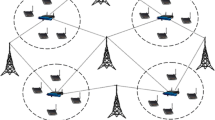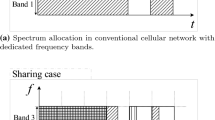Abstract
In this paper, the spectrum sharing problem in cognitive radio is studied as a maximization optimization problem. First, two different optimization models are represented to maximize utilization and fairness in spectrum sharing. Then, an improved Teaching–Learning-Based-Optimization (iTLBO) algorithm is proposed and applied to solve the spectrum sharing optimization problem. Evaluated by 10 benchmark functions, the proposed iTLBO algorithm shows best optimization performance than the other optimization algorithms on most benchmark functions. Finally, the simulation results validate that the proposed spectrum sharing scheme improves both the spectrum utilization and fairness compared to other existing methods.



Similar content being viewed by others
References
Panda, T., Patra, K. C., Alzubi, J. A., Barpanda, N. K., & Palai, G. (2019). Analytical studies on FBG based SOI structure for realization of optical interconnect. Optik - International Journal of Light and Electron Optics., 193, 162979.
Amiri, I. S., Palai, G., Alzubi, J. A., & Nayak, S. R. (2020). Chip to chip communication through the photonic integrated circuit: A new paradigm to optical VLSI. Optik - International Journal of Light and Electron Optics., 202, 163588.
Jin, Z., Yao, K., Lee, B., Cho, J., & Zhang, L. (2019). Channel status learning for cooperative spectrum sensing in energy-restricted cognitive radio networks. IEEE Access, 7, 64946–64954.
Mitola, J., & Maguire, J. Q. (1999). Cognitive radio: Making software radios more personal. IEEE Personal Communications, 6, 13–18.
Zhao, Z., Peng, Z., Zheng, S., & Shang, J. (2009). Cognitive radio spectrum allocation using evolutionary algorithms. IEEE Transactions on Wireless Communications, 8, 4421–4425.
Zheng H, Peng C (2005), Collaboration and fairness in opportunistic spectrum access. In Proc. 40th annual IEEE International Conference on Communications (ICC), pp 3132–3136
Tegou, T. L., et al. (2018). Spectrum allocation in cognitive radio networks using chaotic biogeography-based optimization. IET Networks, 7, 328–335.
Peng, C., Zheng, H., & Zhao, B. Y. (2006). Utilization and fairness in spectrum assignment for opportunistic spectrum access. Mobile Netw. Appl., 11, 555–576.
Rao, V., Savsani, V. J., & Vakharia, D. P. (2011). Teaching–learning-based optimization: A novel method for constrained mechanical design optimization problems. Computer-Aided Design, 43, 303–315.
Tizhoosh, H.R (2005) Opposition-Based Learning: A New Scheme for Machine Intelligence. In Proc. Int. Conf. on Computational Intelligence for Modelling, Control and Automation and International Conference on Intelligent Agents, Web Technologies and Internet Commerce, Vienna, pp 695–701
Xiaoyuan, J., Hu, Y., Jianxin, Z., Yajun, Y., & Xu, S. (2017). An improved teaching-learning-based optimization algorithm and its application to a combinatorial optimization problem in foundry industry. Applied Soft Computing, 57, 504–516.
Liang, J. J., Qin, A. K., Suganthan, P. N., & Baskar, S. (2006). Comprehensive learning particle swarm optimizer for global optimization of multimodal functions. IEEE Transactions on Evolutionary Computation, 10, 281–295.
Brest, J., Greiner, S., Boskovic, B., Mernik, M., & Zumer, V. (2006). Self-adapting control parameters in differential evolution: A comparative study on numerical benchmark problems. IEEE Transactions on Evolutionary Computation, 10, 646–657.
Karaboga, D., & Basturk, B. (2007). A powerful and efficient algorithm for numerical function optimization: Artificial Bee Colony (ABC) algorithm. Journal of Global Optimization, 39, 459–471.
Zou, F., Wang, L., Hei, X., & Chen, D. (2015). Teaching-learning-based optimization with learning experience of other learners and its application. Applied Soft Computing, 37, 725–736.
Funding
None.
Author information
Authors and Affiliations
Corresponding author
Ethics declarations
Conflict of interest
All the authors declared that they have no conflict of interest.
Additional information
Publisher's Note
Springer Nature remains neutral with regard to jurisdictional claims in published maps and institutional affiliations.
Rights and permissions
Springer Nature or its licensor (e.g. a society or other partner) holds exclusive rights to this article under a publishing agreement with the author(s) or other rightsholder(s); author self-archiving of the accepted manuscript version of this article is solely governed by the terms of such publishing agreement and applicable law.
About this article
Cite this article
Askari, M., Dastanian, R. An optimized spectrum sharing scheme for cognitive radio. Wireless Netw 29, 1621–1627 (2023). https://doi.org/10.1007/s11276-022-03193-5
Accepted:
Published:
Issue Date:
DOI: https://doi.org/10.1007/s11276-022-03193-5




